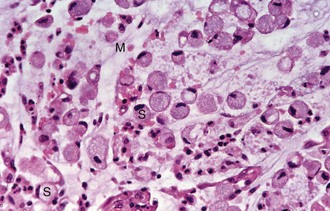Tumours of the stomach and small intestine
Introduction
Tumours of small bowel are rare. Of the malignant tumours, lymphomas and gastrointestinal stromal tumours (GIST) are much more common than adenocarcinomas. Peutz–Jeghers syndrome is a rare inherited disorder characterised by multiple benign polyps in the small bowel and perioral pigmentation plus increased risk of breast, colorectal and other cancers. Patients are fairly commonly encountered at student examinations (see Ch. 27, p. 353).
Carcinoma of stomach
Pathology of gastric carcinoma
Gastric carcinomas are almost exclusively adenocarcinomas. Two distinct histopathological groups are recognised, each with its own epidemiological associations. The intestinal type has histological features similar to intestinal epithelium. Cells grow in clumps and there is marked inflammatory infiltrate. The second variety is the diffuse type. Here the cells are singular, often arranged in single file and surrounded by a marked stromal reaction. Tumour cells have large intracellular mucin droplets which displace the nucleus to the cell periphery, giving the characteristic signet ring appearance (Fig. 23.1). Intestinal-type carcinomas have a better prognosis than mucin-producing signet ring carcinomas.

Fig. 23.1 Signet-ring carcinoma of the stomach—histopathology
High-power view of typical infiltrating type of gastric carcinoma showing numerous signet ring cells S. This appearance is due to the presence of intracellular mucin M
• Fungating tumours—these polypoid lesions may grow to a huge size
• Malignant ulcers—these probably result from necrosis in broad-based solid tumours. Malignant ulcers are often larger than peptic ulcers (except for giant benign ulcers of the elderly) with a heaped-up indurated (hardened) margin
• Infiltrating carcinomas—this form spreads widely beneath the mucosa, and diffusely and extensively invades the muscle wall. This causes thickening and rigidity and the entire stomach contracts to a very small capacity. This is known as linitis plastica and its appearance likened to a ‘leather bottle’. Linitis plastica affects a slightly younger age group than intestinal-type cancer and has a very poor prognosis. Diagnosis may be delayed because endoscopic changes are often subtle and standard biopsies of mucosa may not show malignancy
‘Early gastric cancer’ is defined as cancer limited to the mucosa and submucosa. This is found most often as a result of endoscopic screening or whilst investigating possible peptic ulcer. Results of surgery in this group are excellent, with a surgical cure rate of about 90%.
Aetiology of gastric carcinoma and premalignant conditions
Helicobacter pylori infection
H. pylori is known to initiate peptic ulceration, and chronic H. pylori infection has become a prime suspect for initiating intestinal-type gastric cancer. The organism can colonise gastric mucosa over long periods and cause chronic gastritis which may progress to type B multifocal atrophic gastritis. In one biopsy study of gastric cancers, H. pylori was found in 90% of intestinal-type cancers, whilst only 30% of the diffuse type were infected. The carcinogenic mechanism of H. pylori may involve alterations to the gastric acid–pepsin environment, with increased cell turnover and possibly enhanced mucosal susceptibility to ingested carcinogens. H. pylori eradication does not reverse gastric atrophy but does improve the enzymic and hormonal secretory capacity of the stomach. H. pylori also appears likely to be involved in gastric lymphoma of the mucosa-associated lymphoid tissue (MALT) type (see p. 322).
Clinical features of gastric carcinoma
In advanced disease, up to half the patients are asymptomatic and the rest have pain, nausea, vomiting, anorexia or a feeling of fullness after small meals (early satiety). Sometimes these symptoms are there months before the patient presents. Anaemia from chronic occult blood loss is common and one-third have positive stool tests for occult blood. One-third have cachexia (severe weight loss and wasting). This usually indicates metastatic disease and may be the only manifestation of cancer at the time. Of the 70% who present with advanced local disease (stage T3), more than half have extensive abdominal nodal spread and half have distant metastases. The presenting features of gastric carcinoma are summarised in Box 23.1.







